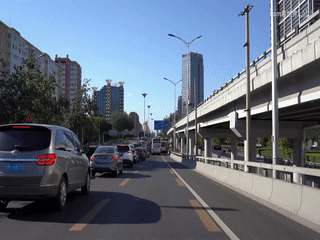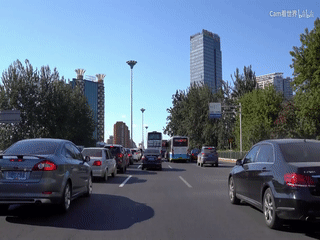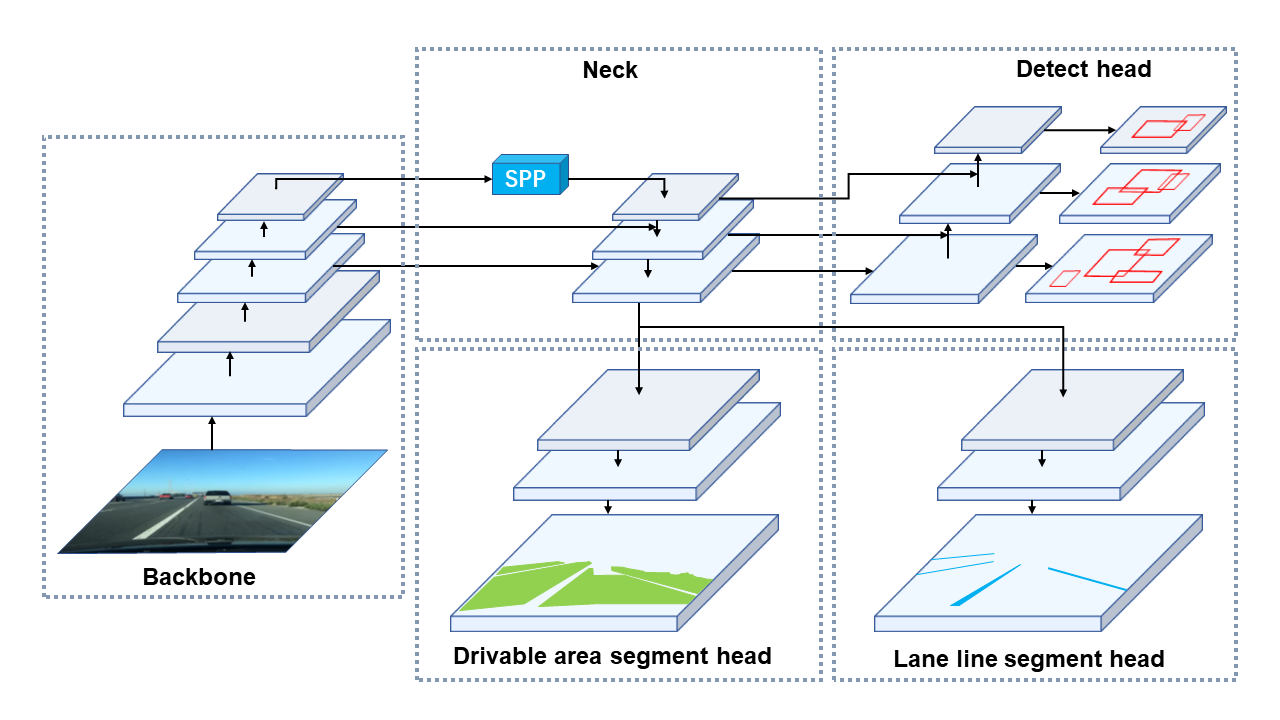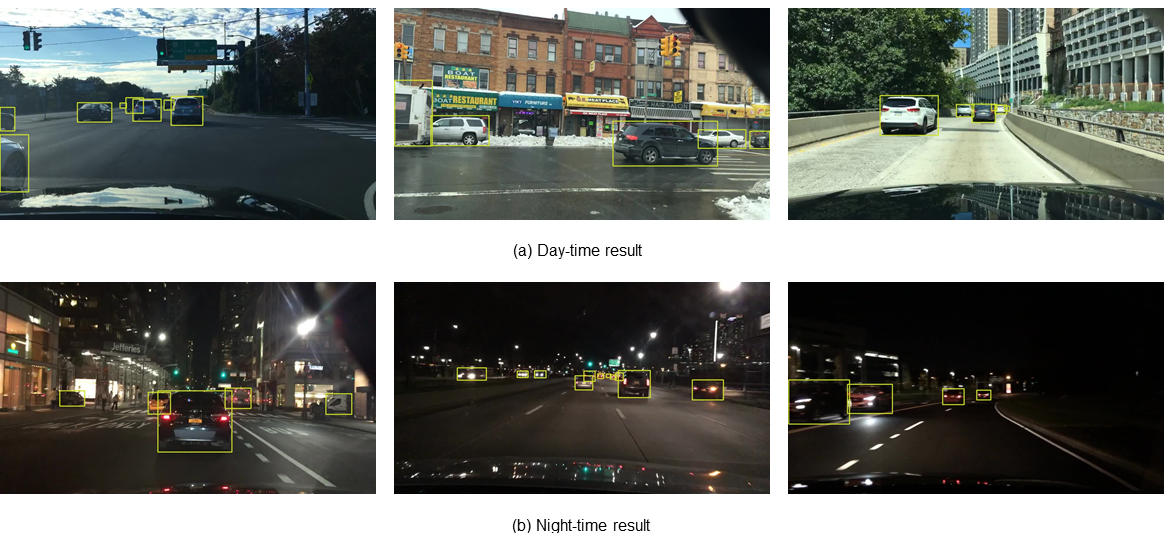You Only Look at Once for Panoptic driving Perception
by Dong Wu, Manwen Liao, Weitian Zhang, Xinggang Wang 📧 School of EIC, HUST
(📧) corresponding author.
arXiv technical report (arXiv 2108.11250)
-
We put forward an efficient multi-task network that can jointly handle three crucial tasks in autonomous driving: object detection, drivable area segmentation and lane detection to save computational costs, reduce inference time as well as improve the performance of each task. Our work is the first to reach real-time on embedded devices while maintaining state-of-the-art level performance on the
BDD100Kdataset. -
We design the ablative experiments to verify the effectiveness of our multi-tasking scheme. It is proved that the three tasks can be learned jointly without tedious alternating optimization.
| Model | Recall(%) | mAP50(%) | Speed(fps) |
|---|---|---|---|
Multinet |
81.3 | 60.2 | 8.6 |
DLT-Net |
89.4 | 68.4 | 9.3 |
Faster R-CNN |
77.2 | 55.6 | 5.3 |
YOLOv5s |
86.8 | 77.2 | 82 |
YOLOP(ours) |
89.2 | 76.5 | 41 |
| Model | mIOU(%) | Speed(fps) |
|---|---|---|
Multinet |
71.6 | 8.6 |
DLT-Net |
71.3 | 9.3 |
PSPNet |
89.6 | 11.1 |
YOLOP(ours) |
91.5 | 41 |
| Model | mIOU(%) | IOU(%) |
|---|---|---|
ENet |
34.12 | 14.64 |
SCNN |
35.79 | 15.84 |
ENet-SAD |
36.56 | 16.02 |
YOLOP(ours) |
70.50 | 26.20 |
| Training_method | Recall(%) | AP(%) | mIoU(%) | Accuracy(%) | IoU(%) |
|---|---|---|---|---|---|
ES-W |
87.0 | 75.3 | 90.4 | 66.8 | 26.2 |
ED-W |
87.3 | 76.0 | 91.6 | 71.2 | 26.1 |
ES-D-W |
87.0 | 75.1 | 91.7 | 68.6 | 27.0 |
ED-S-W |
87.5 | 76.1 | 91.6 | 68.0 | 26.8 |
End-to-end |
89.2 | 76.5 | 91.5 | 70.5 | 26.2 |
| Training_method | Recall(%) | AP(%) | mIoU(%) | Accuracy(%) | IoU(%) | Speed(ms/frame) |
|---|---|---|---|---|---|---|
Det(only) |
88.2 | 76.9 | - | - | - | 15.7 |
Da-Seg(only) |
- | - | 92.0 | - | - | 14.8 |
Ll-Seg(only) |
- | - | - | 79.6 | 27.9 | 14.8 |
Multitask |
89.2 | 76.5 | 91.5 | 70.5 | 26.2 | 24.4 |
Notes:
- The works we has use for reference including
Multinet(paper,code),DLT-Net(paper),Faster R-CNN(paper,code),YOLOv5s(code) ,PSPNet(paper,code) ,ENet(paper,code)SCNN(paper,code)SAD-ENet(paper,code). Thanks for their wonderful works. - In table 4, E, D, S and W refer to Encoder, Detect head, two Segment heads and whole network. So the Algorithm (First, we only train Encoder and Detect head. Then we freeze the Encoder and Detect head as well as train two Segmentation heads. Finally, the entire network is trained jointly for all three tasks.) can be marked as ED-S-W, and the same for others.
Notes:
- The visualization of lane detection result has been post processed by quadratic fitting.
├─inference
│ ├─images # inference images
│ ├─output # inference result
├─lib
│ ├─config/default # configuration of training and validation
│ ├─core
│ │ ├─activations.py # activation function
│ │ ├─evaluate.py # calculation of metric
│ │ ├─function.py # training and validation of model
│ │ ├─general.py #calculation of metric、nms、conversion of data-format、visualization
│ │ ├─loss.py # loss function
│ │ ├─postprocess.py # postprocess(refine da-seg and ll-seg, unrelated to paper)
│ ├─dataset
│ │ ├─AutoDriveDataset.py # Superclass dataset,general function
│ │ ├─bdd.py # Subclass dataset,specific function
│ │ ├─hust.py # Subclass dataset(Campus scene, unrelated to paper)
│ │ ├─convect.py
│ │ ├─DemoDataset.py # demo dataset(image, video and stream)
│ ├─models
│ │ ├─YOLOP.py # Setup and Configuration of model
│ │ ├─light.py # Model lightweight(unrelated to paper, zwt)
│ │ ├─commom.py # calculation module
│ ├─utils
│ │ ├─augmentations.py # data augumentation
│ │ ├─autoanchor.py # auto anchor(k-means)
│ │ ├─split_dataset.py # (Campus scene, unrelated to paper)
│ │ ├─utils.py # logging、device_select、time_measure、optimizer_select、model_save&initialize 、Distributed training
│ ├─run
│ │ ├─dataset/training time # Visualization, logging and model_save
├─tools
│ │ ├─demo.py # demo(folder、camera)
│ │ ├─test.py
│ │ ├─train.py
├─toolkits
│ │ ├─deploy # Deployment of model
├─weights # Pretraining modelThis codebase has been developed with python version 3.7, PyTorch 1.7+ and torchvision 0.8+:
conda install pytorch==1.7.0 torchvision==0.8.0 cudatoolkit=10.2 -c pytorch
See requirements.txt for additional dependencies and version requirements.
pip install -r requirements.txt
-
Download the images from images.
-
Download the annotations of detection from det_annotations.
-
Download the annotations of drivable area segmentation from da_seg_annotations.
-
Download the annotations of lane line segmentation from ll_seg_annotations.
We recommend the dataset directory structure to be the following:
# The id represent the correspondence relation
├─dataset root
│ ├─images
│ │ ├─train
│ │ ├─val
│ ├─det_annotations
│ │ ├─train
│ │ ├─val
│ ├─da_seg_annotations
│ │ ├─train
│ │ ├─val
│ ├─ll_seg_annotations
│ │ ├─train
│ │ ├─val
Update the your dataset path in the ./lib/config/default.py.
You can set the training configuration in the ./lib/config/default.py. (Including: the loading of preliminary model, loss, data augmentation, optimizer, warm-up and cosine annealing, auto-anchor, training epochs, batch_size).
If you want try alternating optimization or train model for single task, please modify the corresponding configuration in ./lib/config/default.py to True. (As following, all configurations is False, which means training multiple tasks end to end).
# Alternating optimization
_C.TRAIN.SEG_ONLY = False # Only train two segmentation branchs
_C.TRAIN.DET_ONLY = False # Only train detection branch
_C.TRAIN.ENC_SEG_ONLY = False # Only train encoder and two segmentation branchs
_C.TRAIN.ENC_DET_ONLY = False # Only train encoder and detection branch
# Single task
_C.TRAIN.DRIVABLE_ONLY = False # Only train da_segmentation task
_C.TRAIN.LANE_ONLY = False # Only train ll_segmentation task
_C.TRAIN.DET_ONLY = False # Only train detection taskStart training:
python tools/train.pyYou can set the evaluation configuration in the ./lib/config/default.py. (Including: batch_size and threshold value for nms).
Start evaluating:
python tools/test.py --weights weights/End-to-end.pthWe provide two testing method.
You can store the image or video in --source, and then save the reasoning result to --save-dir
python tools/demo.py --source inference/imagesIf there are any camera connected to your computer, you can set the source as the camera number(The default is 0).
python tools/demo.py --source 0| input | output |
|---|---|
 |
 |
 |
 |
Our model can reason in real-time on Jetson Tx2, with Zed Camera to capture image. We use TensorRT tool for speeding up. We provide code for deployment and reasoning of model in ./toolkits/deploy.
Before reasoning with TensorRT C++ API, you need to transfer the .pth file into binary file which can be read by C++.
python toolkits/deploy/gen_wts.pyAfter running the above command, you obtain a binary file named yolop.wts.
TensorRT needs an engine file for inference. Building an engine is time-consuming. It is convenient to save an engine file so that you can reuse it every time you run the inference. The process is integrated in main.cpp. It can determine whether to build an engine according to the existence of your engine file.
- YOLOP OpenCV-DNN C++ Demo: YOLOP-opencv-dnn from hpc203
- YOLOP ONNXRuntime C++ Demo: lite.ai.toolkit from DefTruth
- YOLOP NCNN C++ Demo: YOLOP-NCNN from EdVince
- YOLOP MNN C++ Demo: YOLOP-MNN from DefTruth
- YOLOP TNN C++ Demo: YOLOP-TNN from DefTruth
If you find our paper and code useful for your research, please consider giving a star ⭐ and citation 📝 :
@misc{2108.11250,
Author = {Dong Wu and Manwen Liao and Weitian Zhang and Xinggang Wang},
Title = {YOLOP: You Only Look Once for Panoptic Driving Perception},
Year = {2021},
Eprint = {arXiv:2108.11250},
}



